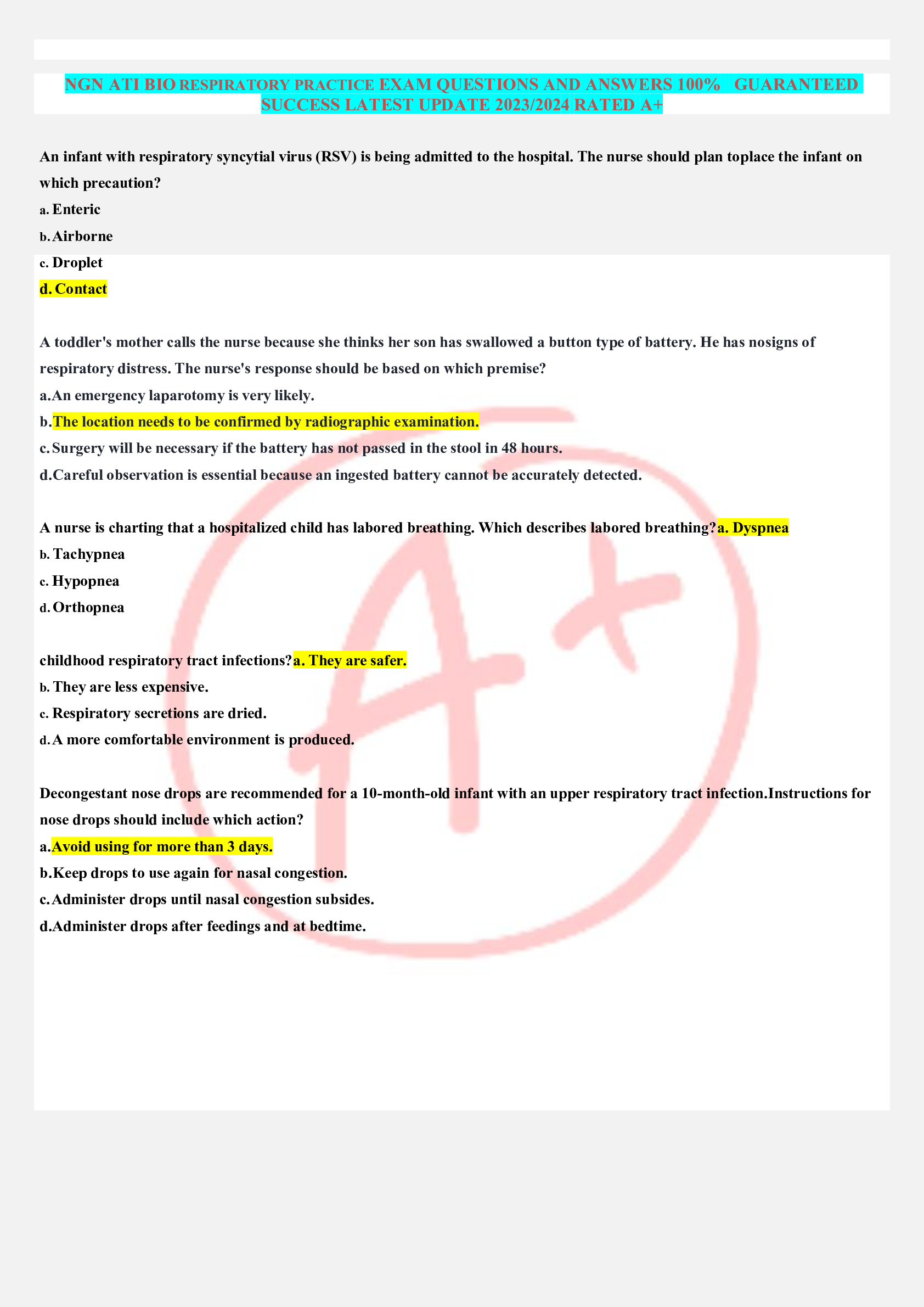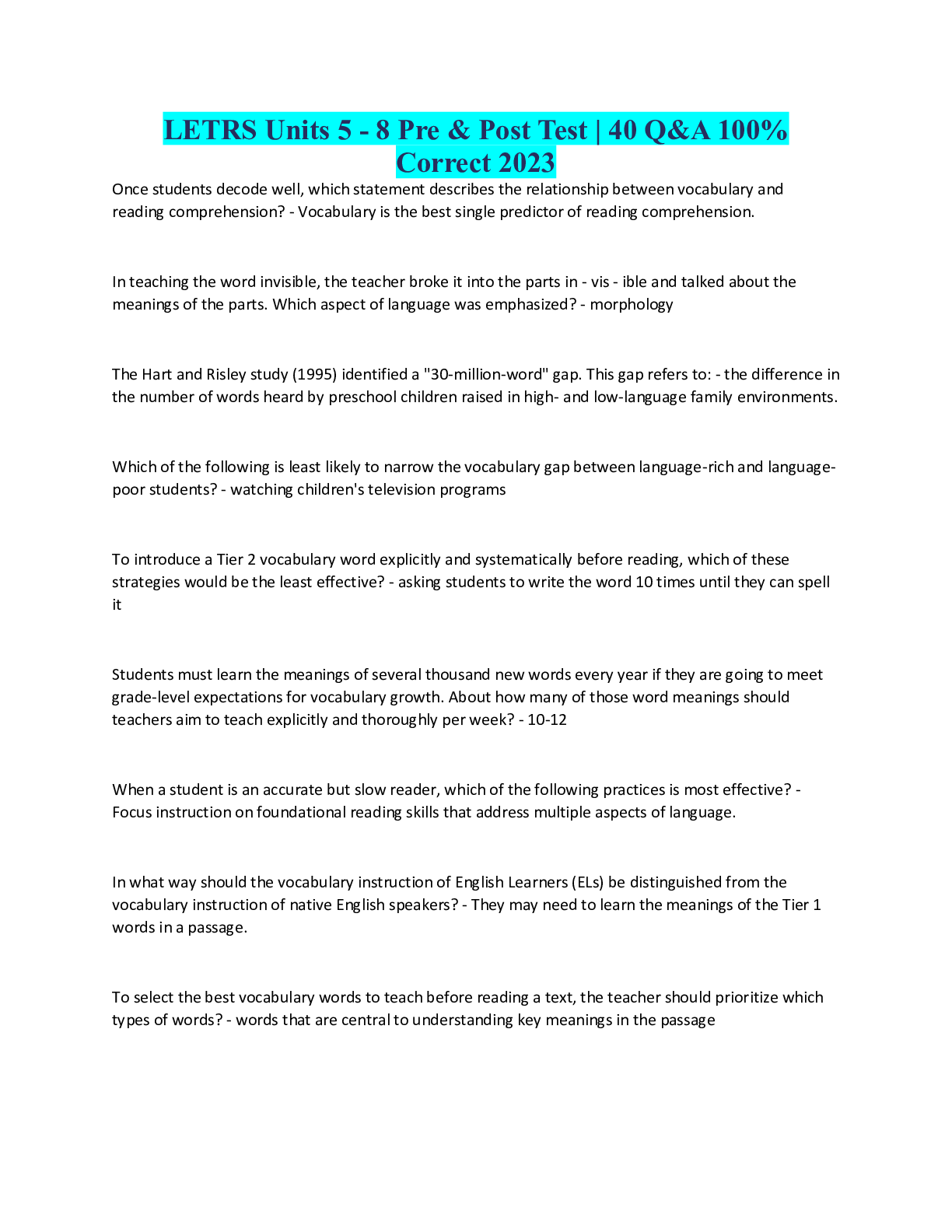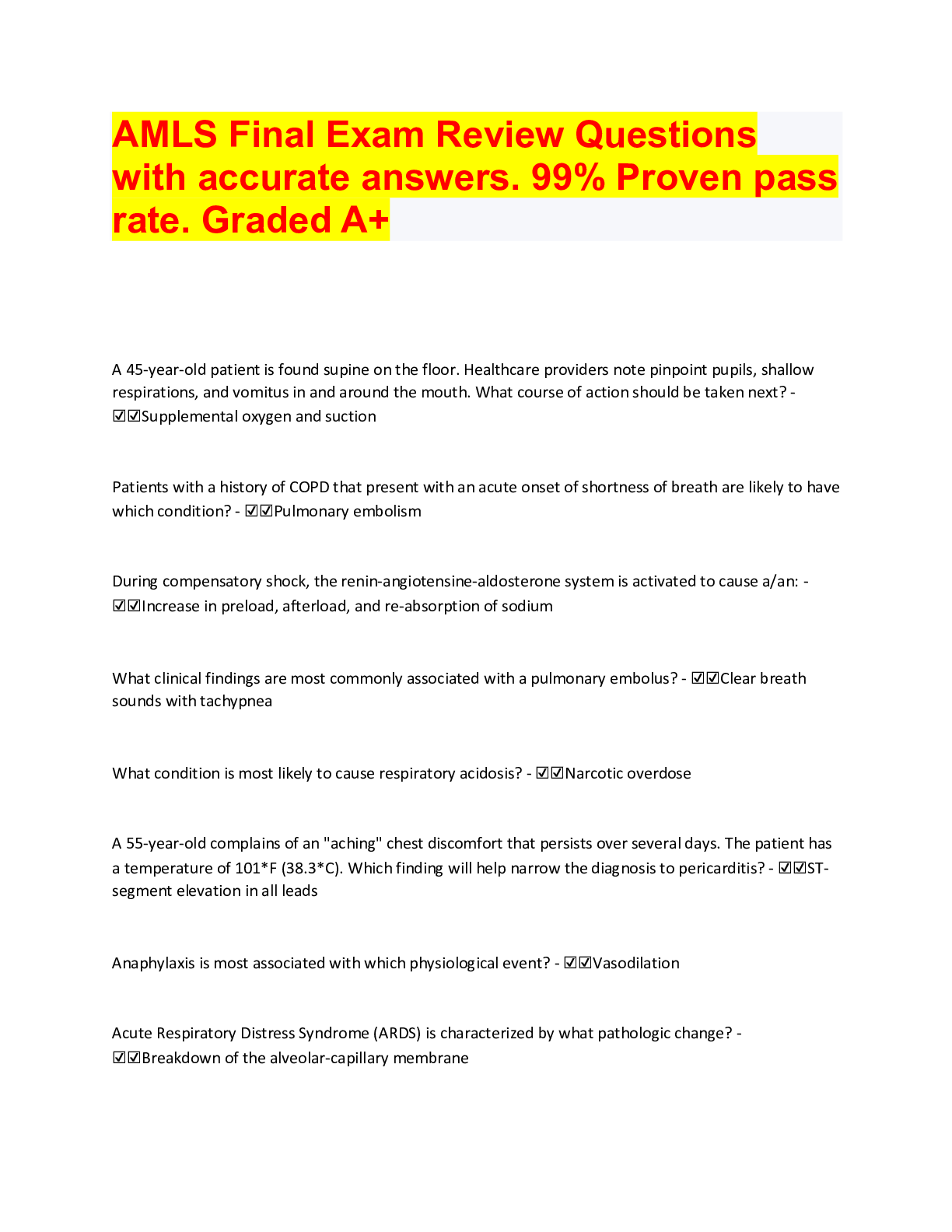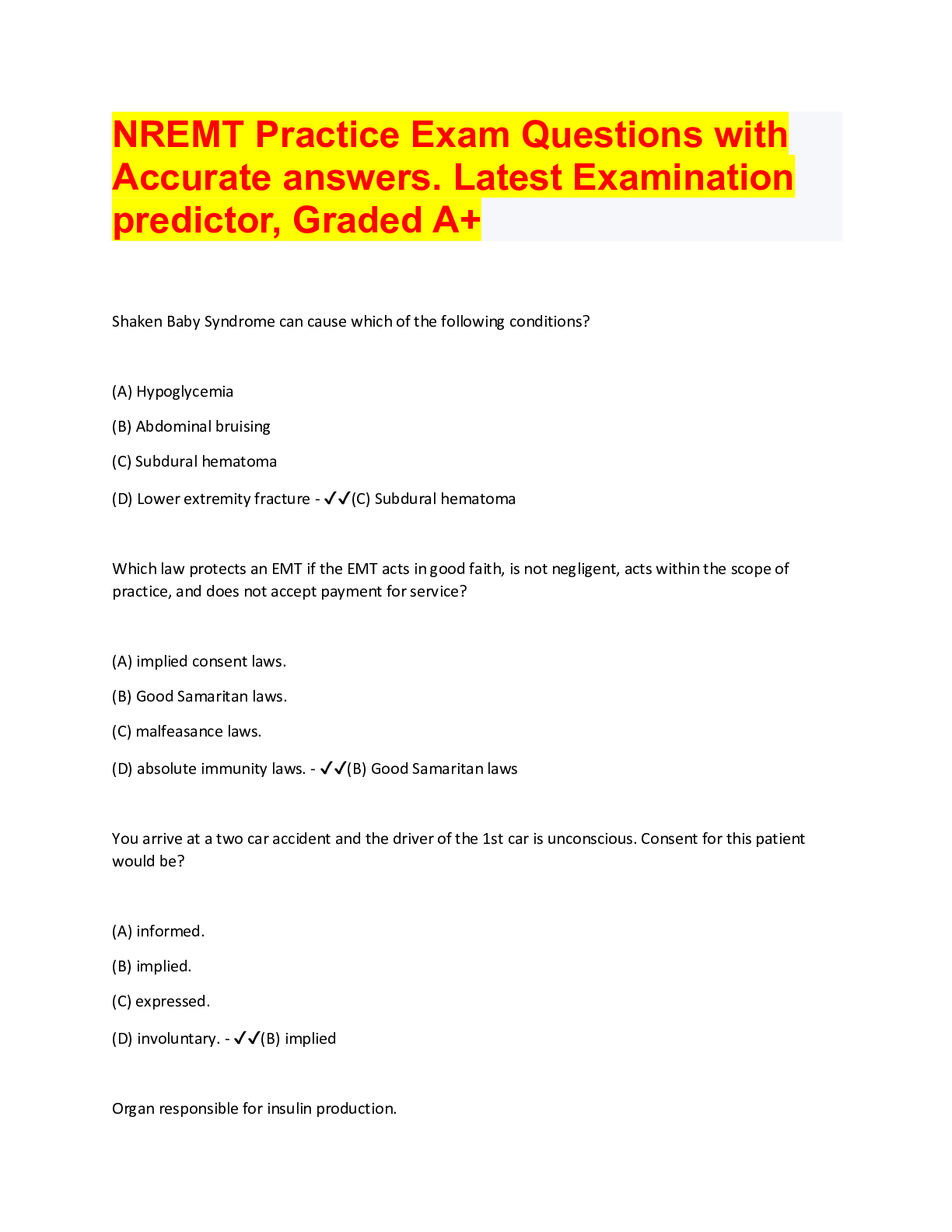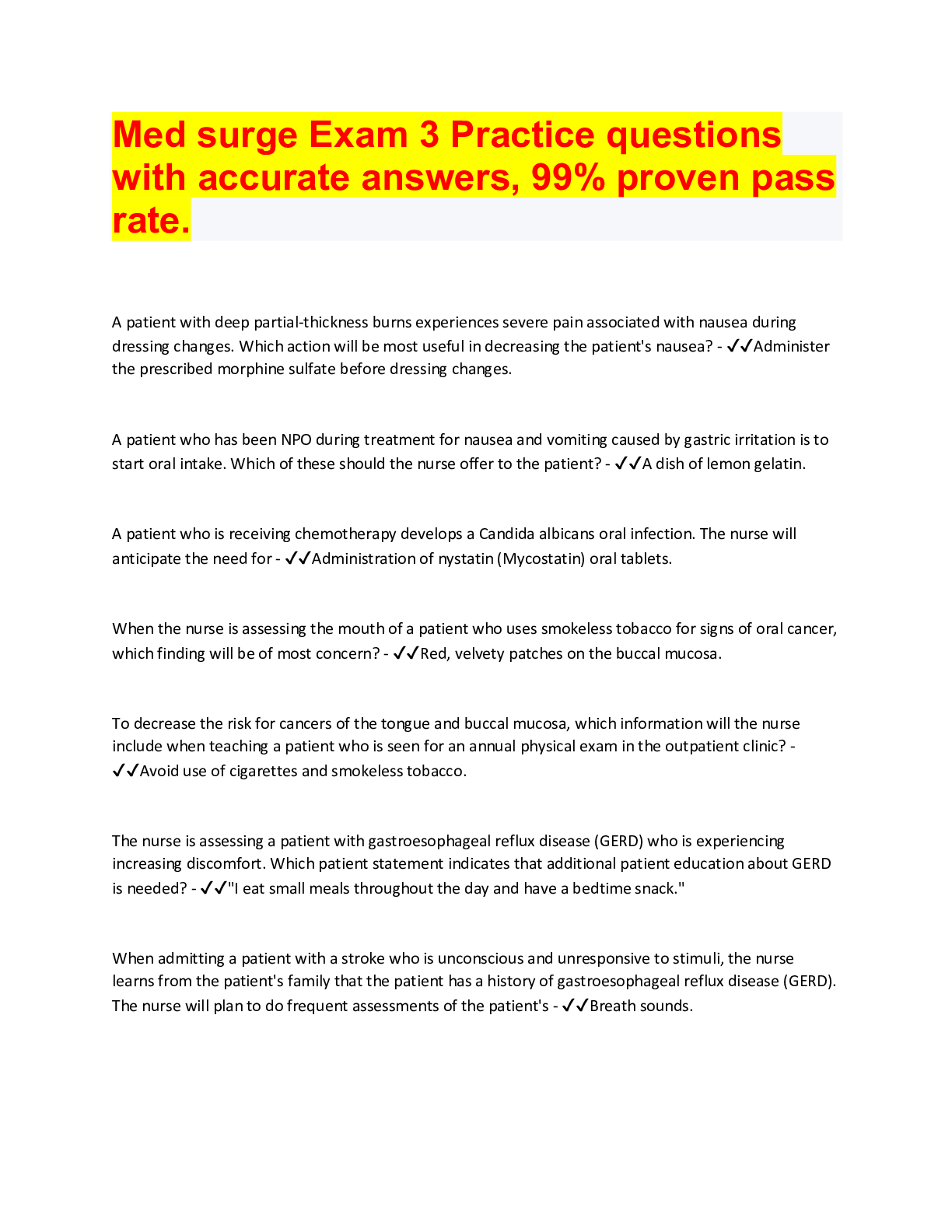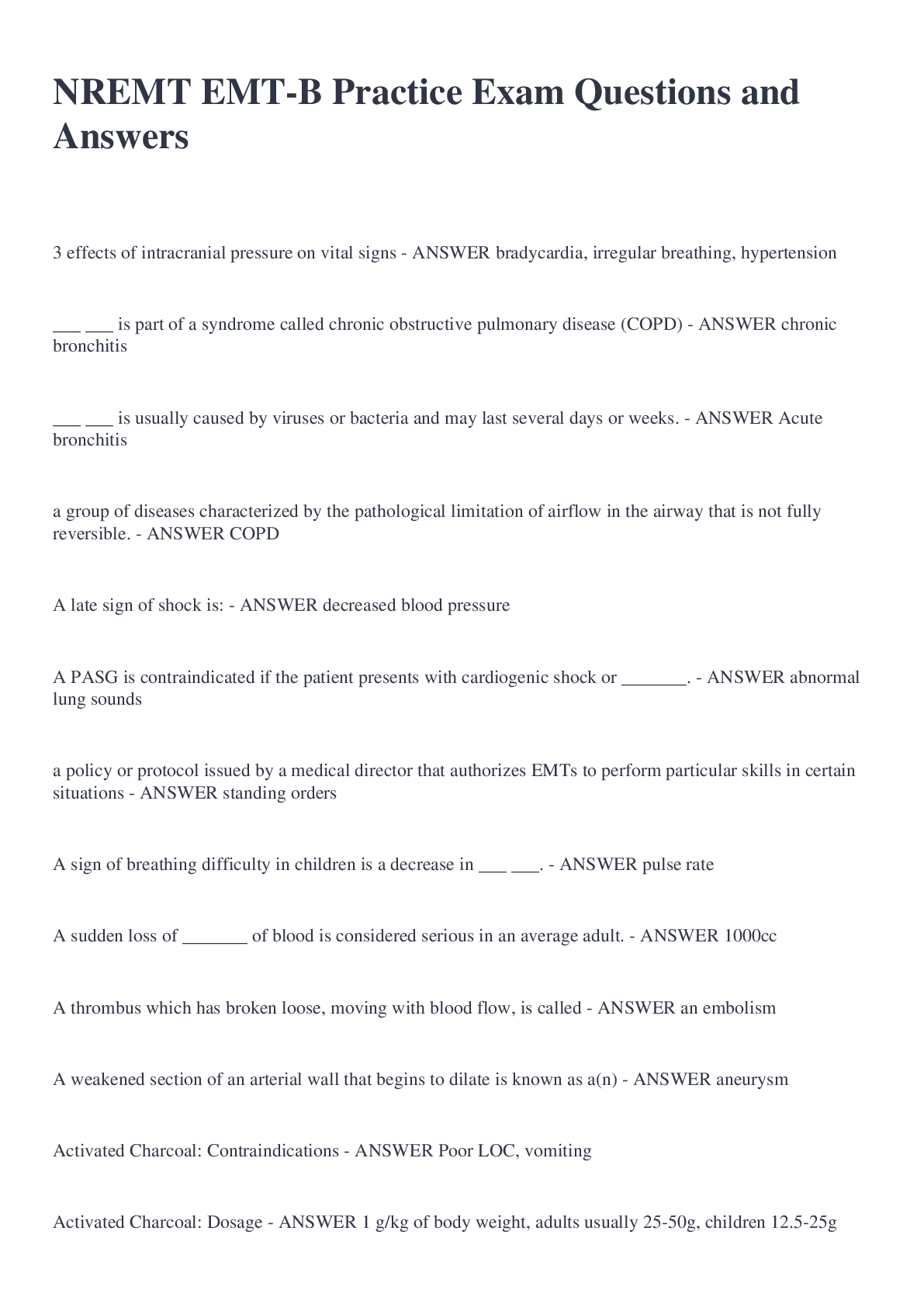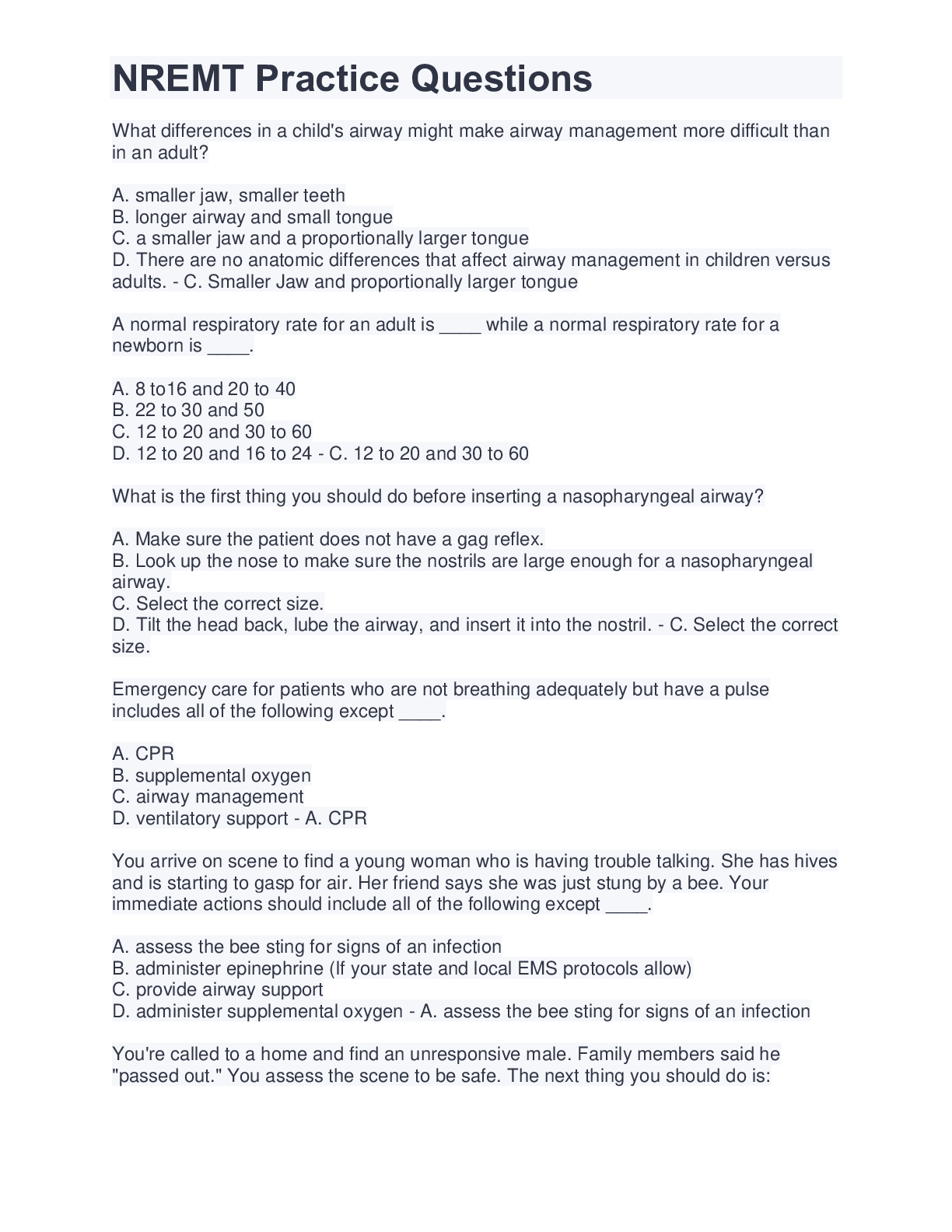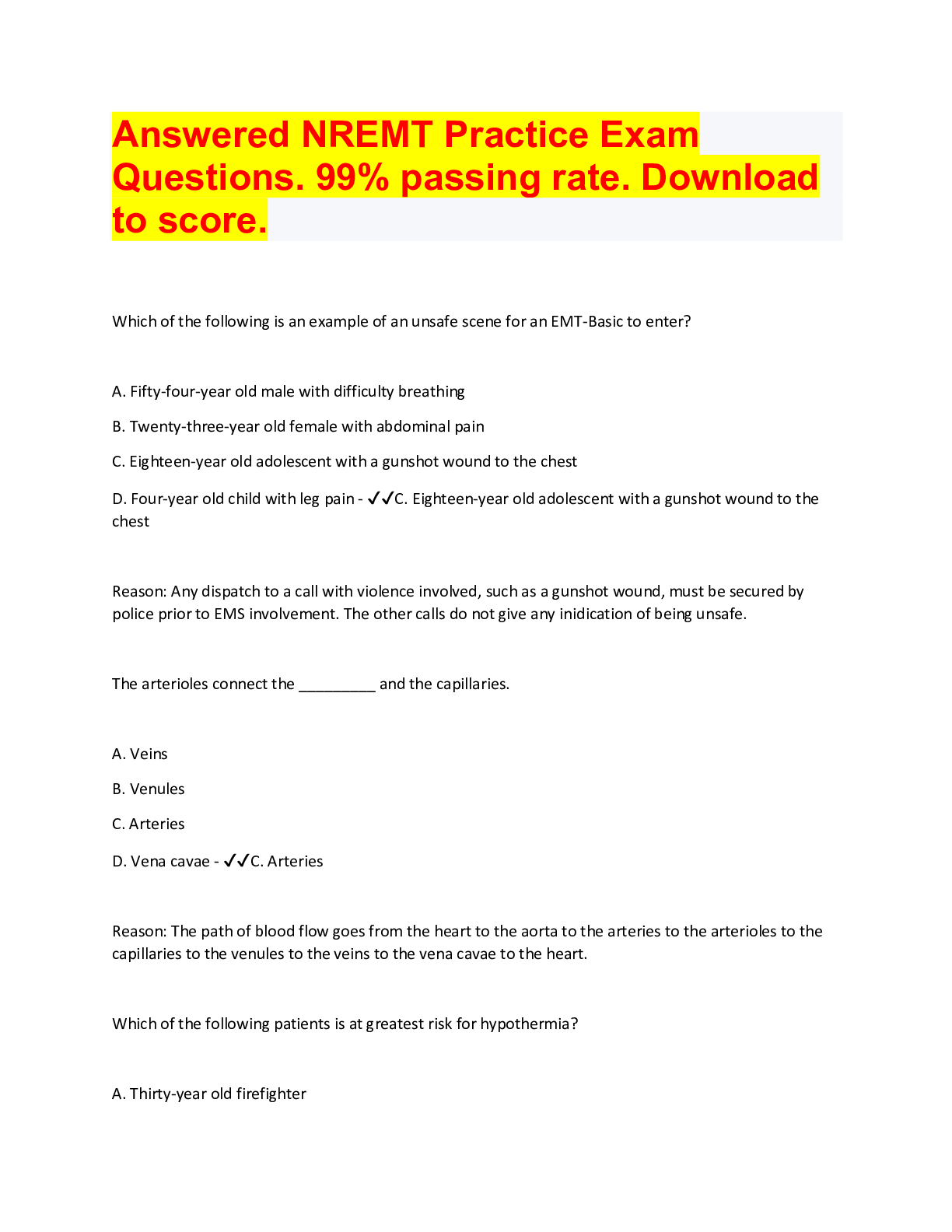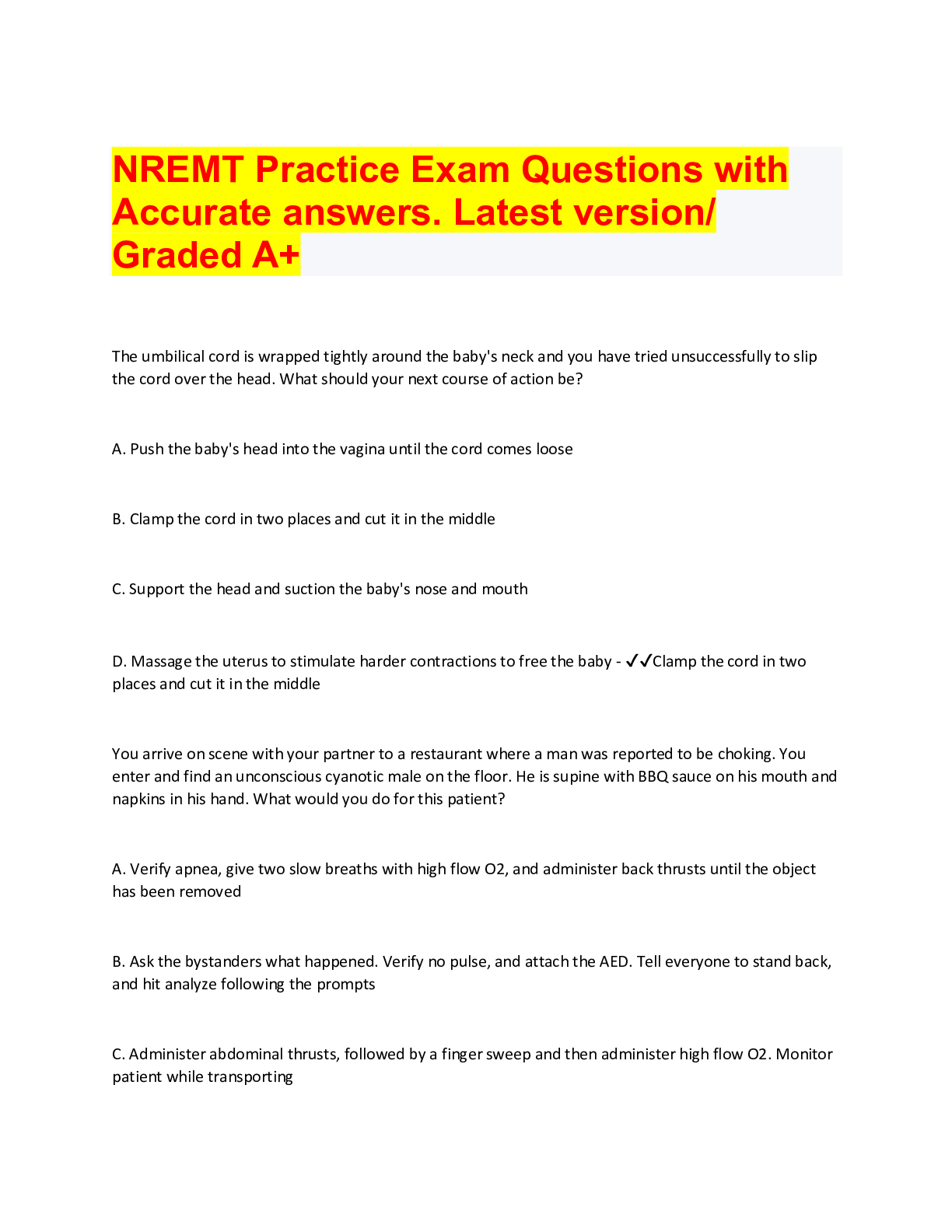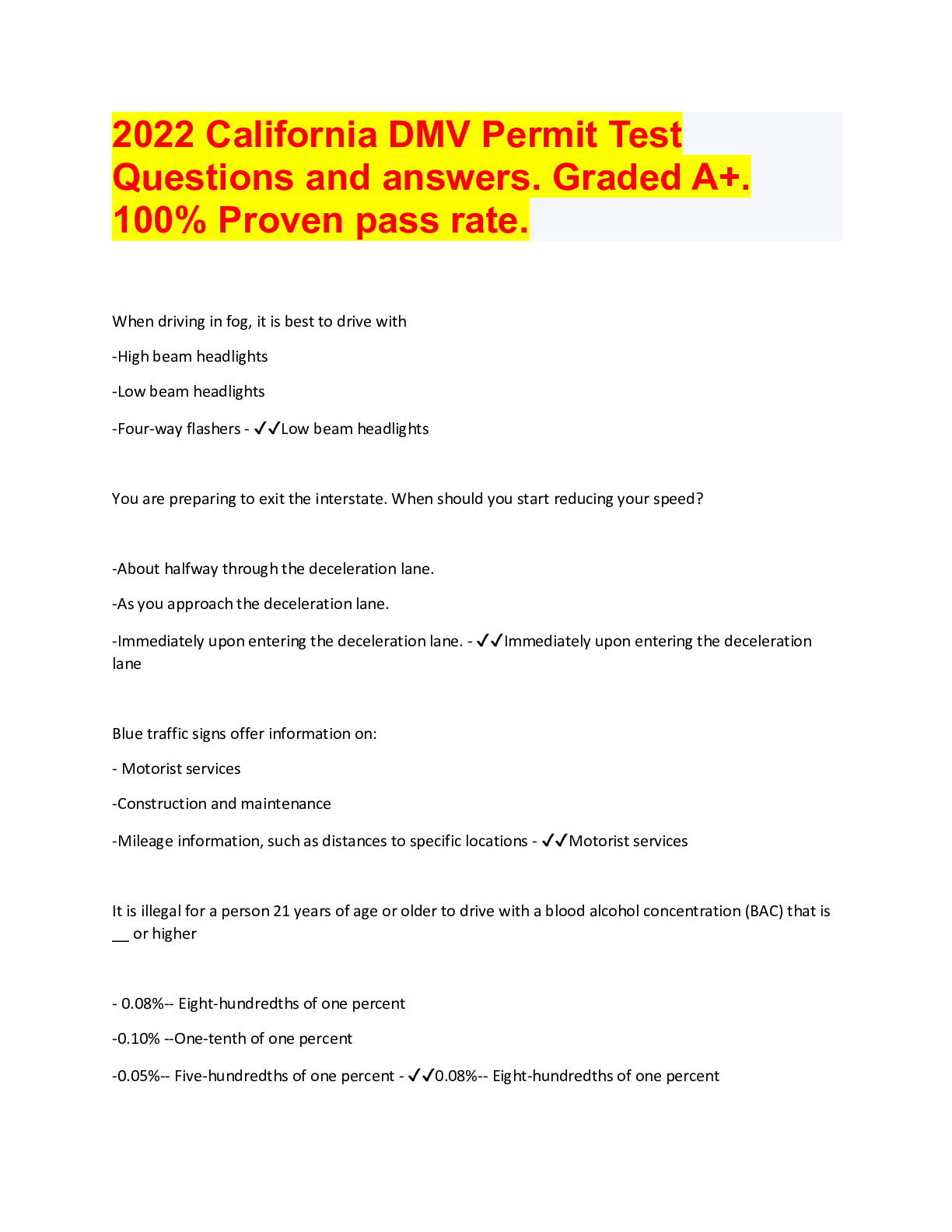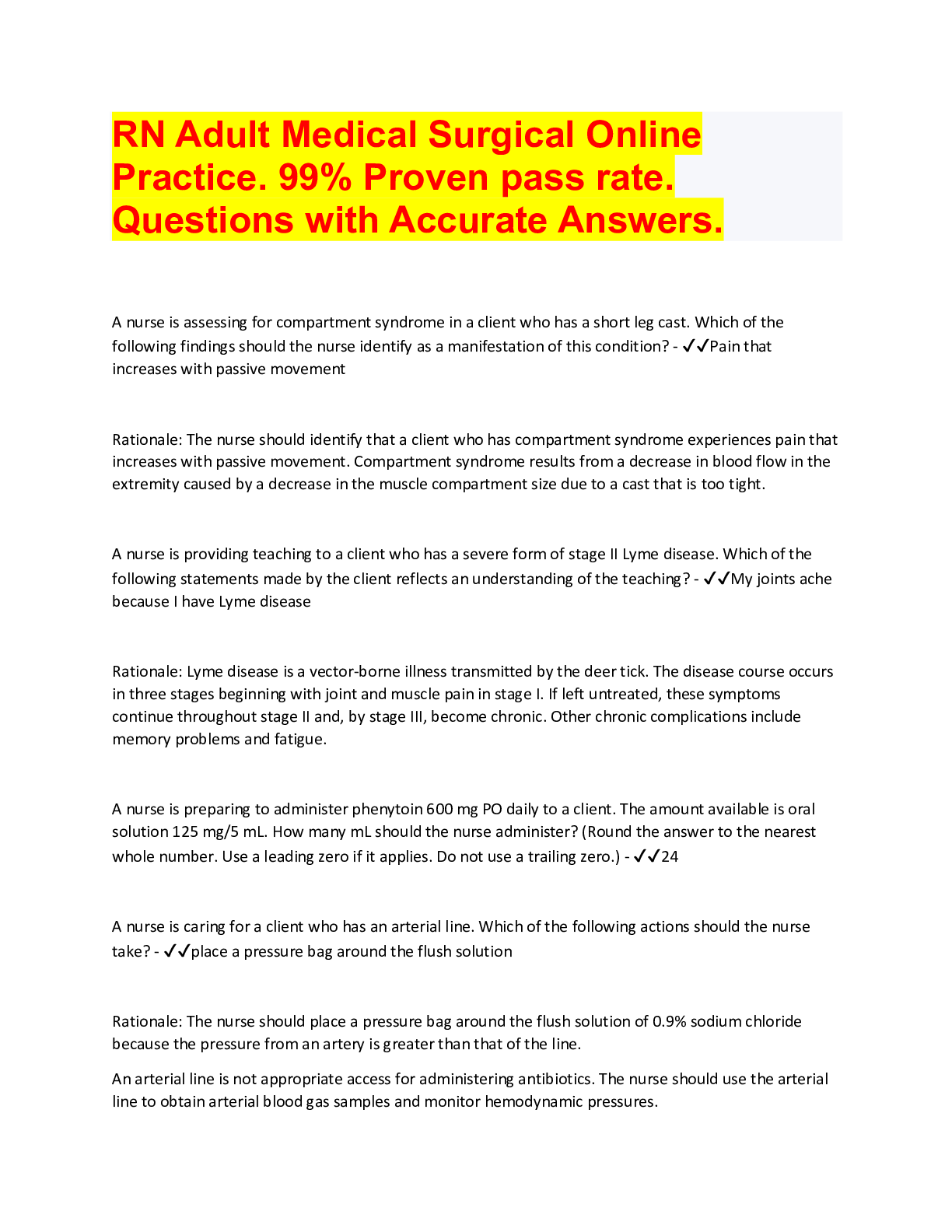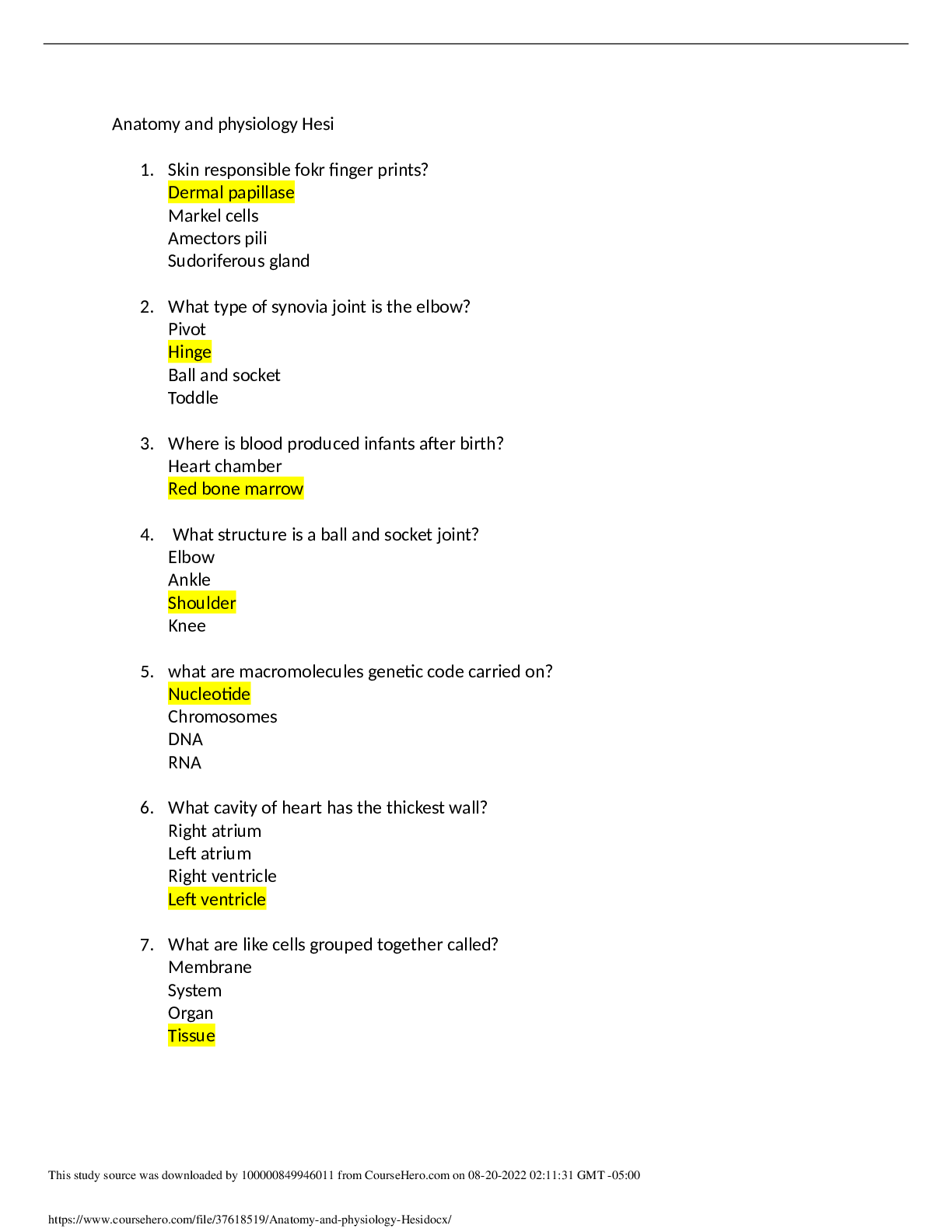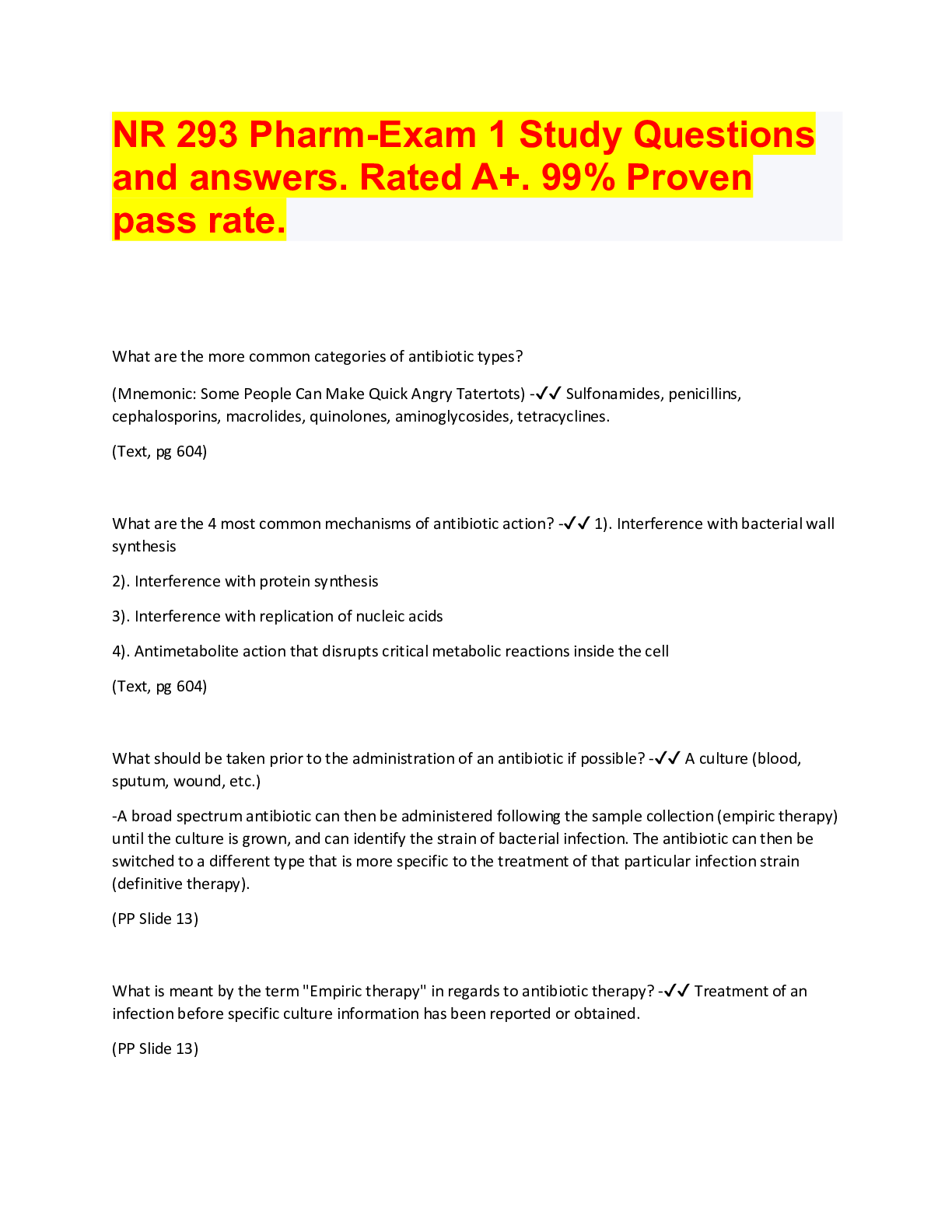*NURSING > QUESTIONS & ANSWERS > Kettering TMC practice exam Questions and answers, Rated A+. Latest Update. 99% proven pass rate (All)
Kettering TMC practice exam Questions and answers, Rated A+. Latest Update. 99% proven pass rate
Document Content and Description Below
A respiratory therapist enters a patient's room during oxygen rounds. The patient has end - stage emphysema and appears to be sleeping. The patient doesn't respond to questions and his pulse is 20 bpm... . The therapist should immediately. A. Confirm DNR status B. Go get help C. Begin rescue ventilation D. Begin chest compressions - ☑☑Confirm DNR status Which of the following clinical observations is most commonly associated with right heart failure? A Peripheral edema B. Muscle wasting C. Tracheal deviation D. Skin flushing - ☑☑Peripheral edema Which of the following is the definitive method of monitoring the effectiveness of equipment sterilization? A. Heat sensitive tape B. Chemical sensitive indicator C. Biologic indicator D. Time and temperature graph - ☑☑Biologic indicator A patient who is receiving mechanical ventilation requires an FiO2 of 0.70 and 10 cm H2O PEEP to maintain an acceptable PaO2. The patient is restless and has become disconnected from the ventilator circuit several times, during which she experiences cardiac rhythm disturbances. A respiratory therapist should conclude that the patient with benefit from a: A. Sedative B. Mucolytic C. Neuromuscular blocker D. Pulmonary vasodilator - ☑☑Sedative Lams and Pams What is signs? - ☑☑What you see What is symptoms? - ☑☑What the patient tells you What is the normal Urine output? - ☑☑40 ml What is Hypovolemia? What would you recommend? - ☑☑low CVP Give fluids What is semicomatose? - ☑☑Patient responds to pain only What is Lethargy/Somnolence? What would you recommend? - ☑☑Sleepy Consider sleep apnea COPD patients is getting to much oxygen ADL are evaluated using the ___________________ system - ☑☑Katz What is orthopnea? What patients would you see this in? - ☑☑Cannot breathe laying flat Seen in CHF patients What is General Malaise? - ☑☑Electrolyte imbalance What is dyspnea? - ☑☑Shortness of breath What is dysphagia? - ☑☑Having a hard time swallowing What is Peripheral Edema? What patients is it seen in? - ☑☑Fluid in the arms and ankles Seen in CHF patients Seen in Renal failure What is Ascites? What patients is it seen in? - ☑☑Fluid in the abdomen Seen in Liver failure patients What is clubbing? What patients is it seen it? - ☑☑Chronic hypoxia Seen in COPD patients What patients will you see JVD in? - ☑☑CHF patients What is Capillary Refill? - ☑☑Color returns within 3 seconds What is diaphoresis? - ☑☑Heavy sweating Seen in CHF patients Seen with Fever and infections Seen with Anxiety and Nervousness Seen with TB/ night sweats What is Ashen/Pallor? - ☑☑Anemia Acute blood loss What is Erythema? - ☑☑inflammation or Infection What is Cyanosis? - ☑☑Lack of oxygen What is associated with Convex Curvature of the Spine (lean Forward)? - ☑☑Kyphosis Restrictive disease What is associated with Lateral Curvature of the Spine (lean side to side)? - ☑☑Scoliosis Restrictive disease What is Barrel Chest? Who would you see Barrel Chest in? - ☑☑Air trapping in the lungs Increase in A-P diameter Seen in COPD patients What is Asymmetrical Chest movement? Who would you see it in? - ☑☑Only one side of the chest is moving Post lung resection Post - pneumonectomy Atelectasis Pneumothorax Flail chest - Paradoxical chest movement Endotracheal tube inserted in the right mainstem bronchi What is Eupnea? - ☑☑Normal breathing What is Tachypnea? Who is this seen in? - ☑☑Breathing over 20 breaths a minute Hypoxia Fever Pain CNS problem What is Bradypnea? Who is this seen in? - ☑☑Breathing less then 12 breaths a minute Drugs Alcohol Metabolic disorders What is Cheyne - Stokes? Who is this seen in? - ☑☑Gradually increasing then decreasing rate and depth in a cycle lasting from 30 to 180 seconds, with periods of apnea lasting up to 60 seconds. Increased ICP Brainstem injury Drug overdose What is Biot's ? Who is it seen in? - ☑☑Increased respiratory rate and depth with irregular periods of apnea. Each breath has the same depth. CNS problem What is Kussmaul's? Who is it seen in? - ☑☑Increased respiratory rate (usually over 20 breaths/ min), increased depth, irregular rhythm, breaths sounds are labored. Metabolic acidosis Renal failure Diabetic ketoacidosis What causes hypertrophy of the accessory muscles? What type of patient might this be present in? - ☑☑Increase in muscle size Seen in COPD patients What is wasting away of muscles referred to as? - ☑☑Atrophy [Show More]
Last updated: 1 year ago
Preview 1 out of 16 pages
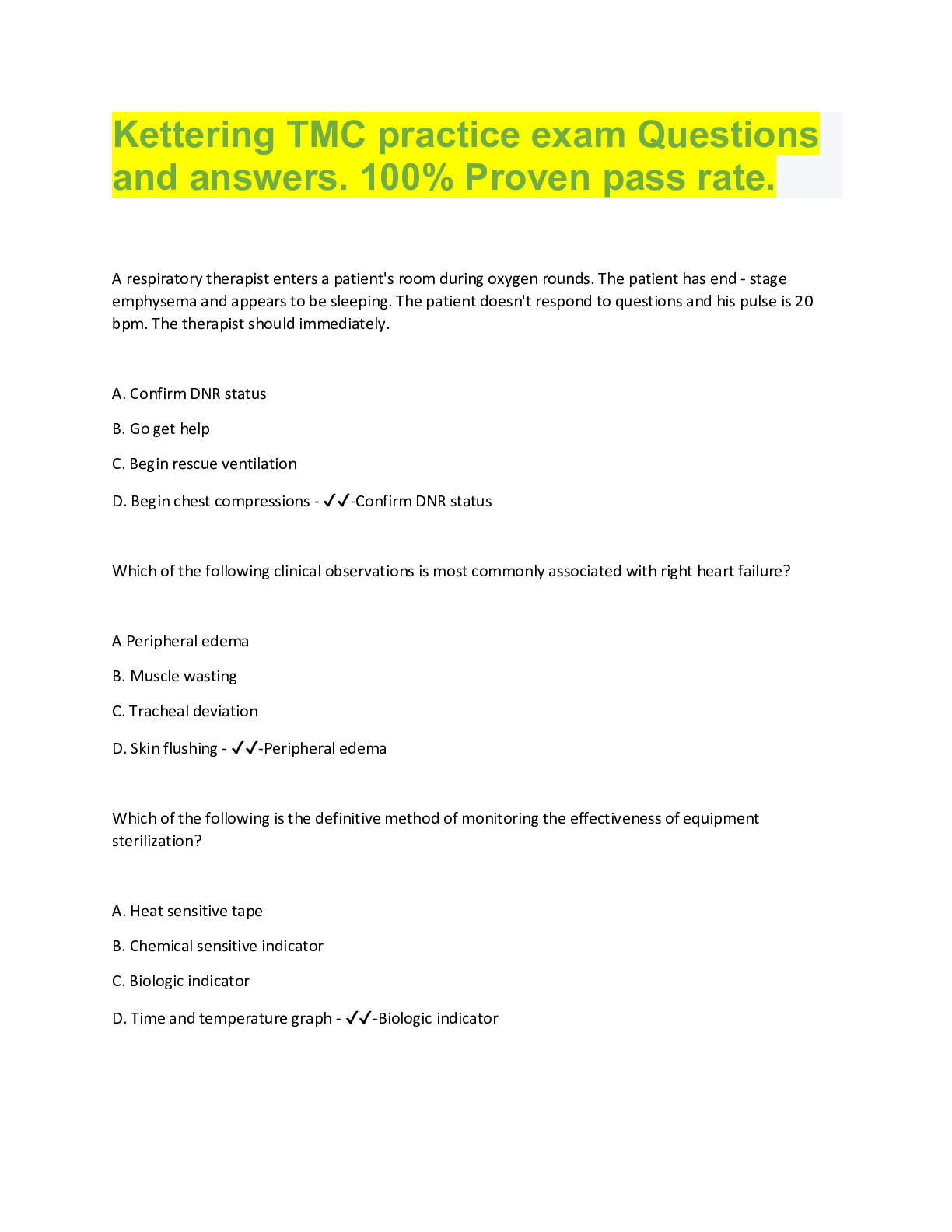
Also available in bundle (2)
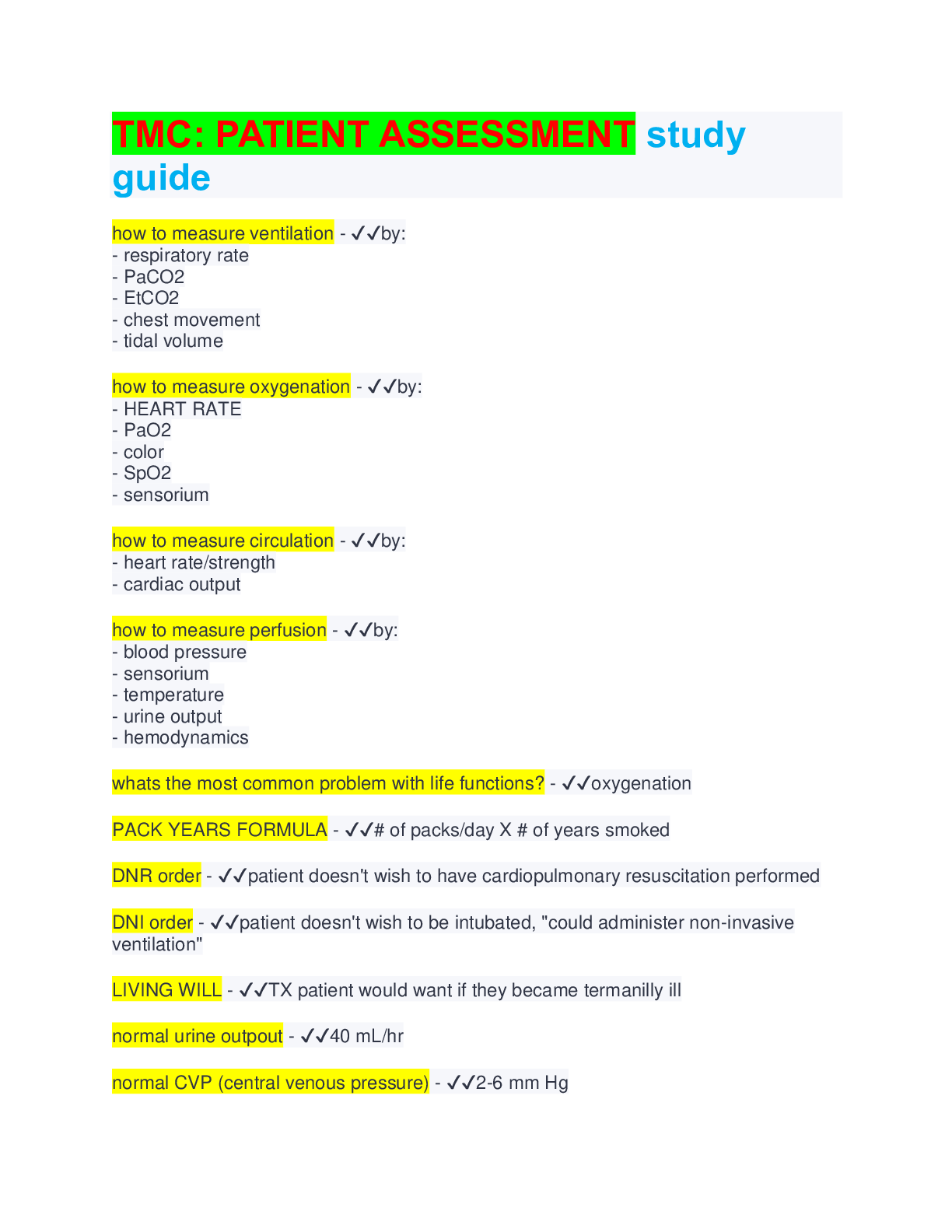
All TMC practice questions papers with answers. Bank questions. Download to score A
Most sought TMC revision kits. Guaranteed comprehension/ GRADE A+
By bundleHub Solution guider 1 year ago
$35
8
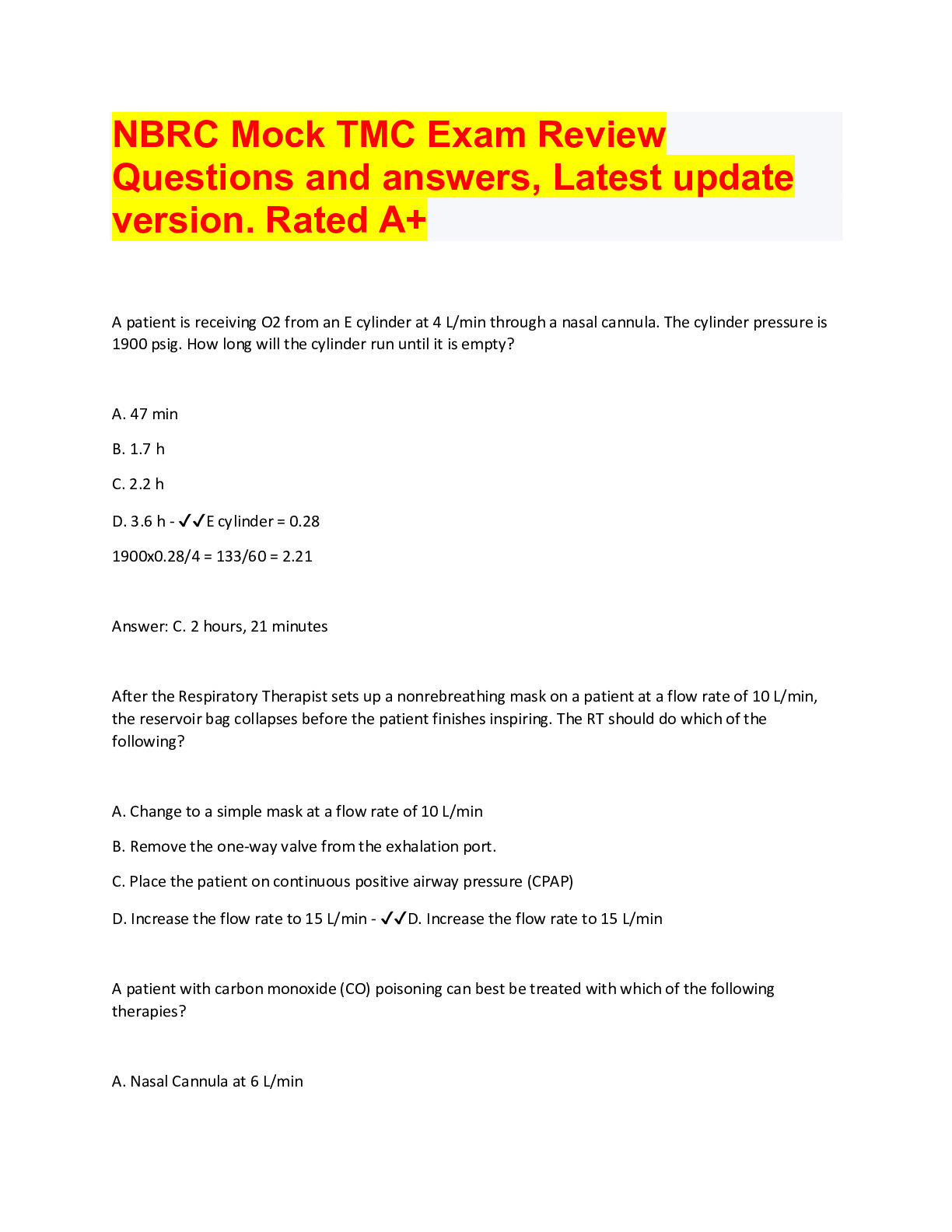
TMC EXAM BUNDLE, QUESTIONS WITH ACCURATE ANSWERS
ALL VERSIONS OF TMC EXAM PAPERS, BUNDLED QUESTIONS WITH ANSWERS, LATEST UPDATES
By bundleHub Solution guider 1 year ago
$38
16
Reviews( 0 )
Document information
Connected school, study & course
About the document
Uploaded On
Aug 07, 2022
Number of pages
16
Written in
Additional information
This document has been written for:
Uploaded
Aug 07, 2022
Downloads
0
Views
102

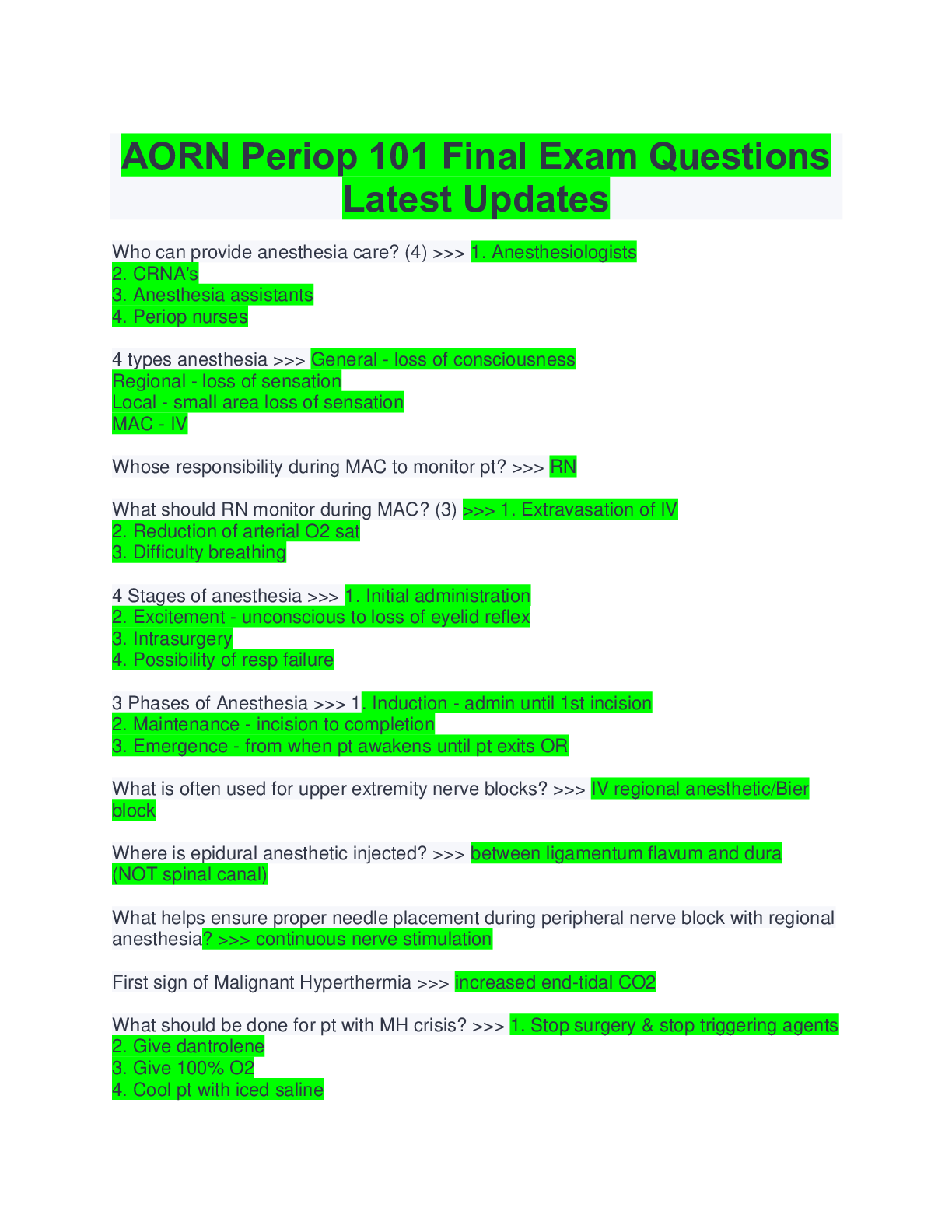






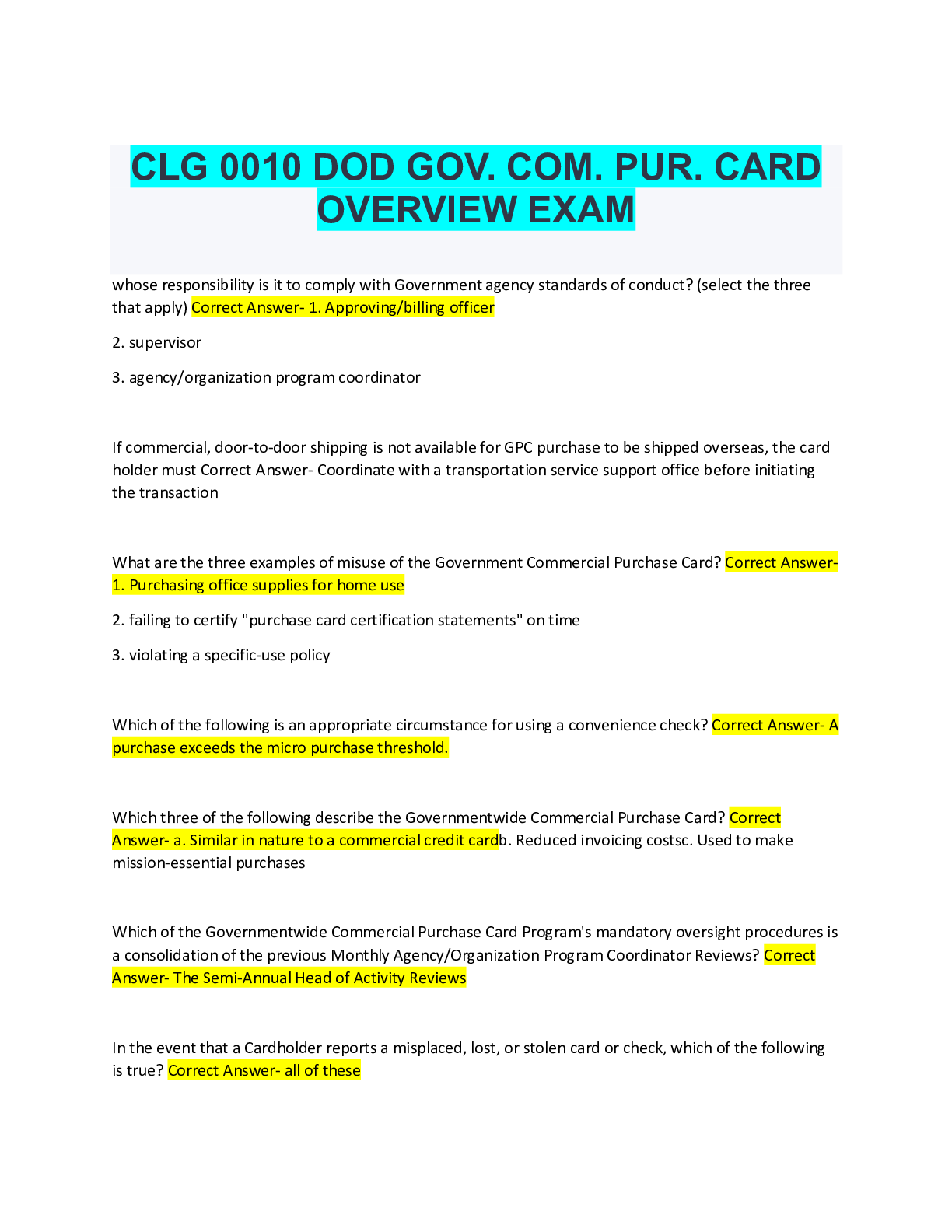


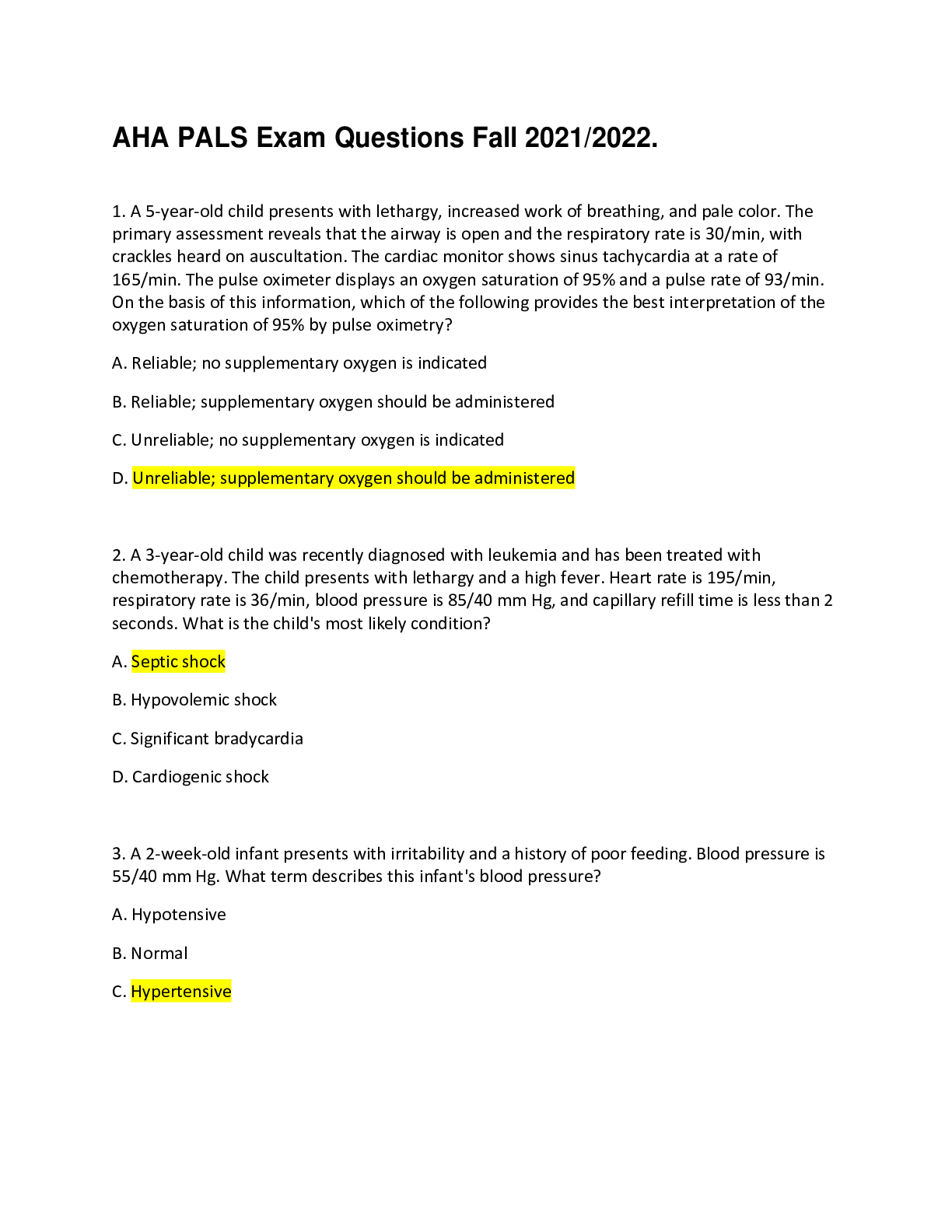

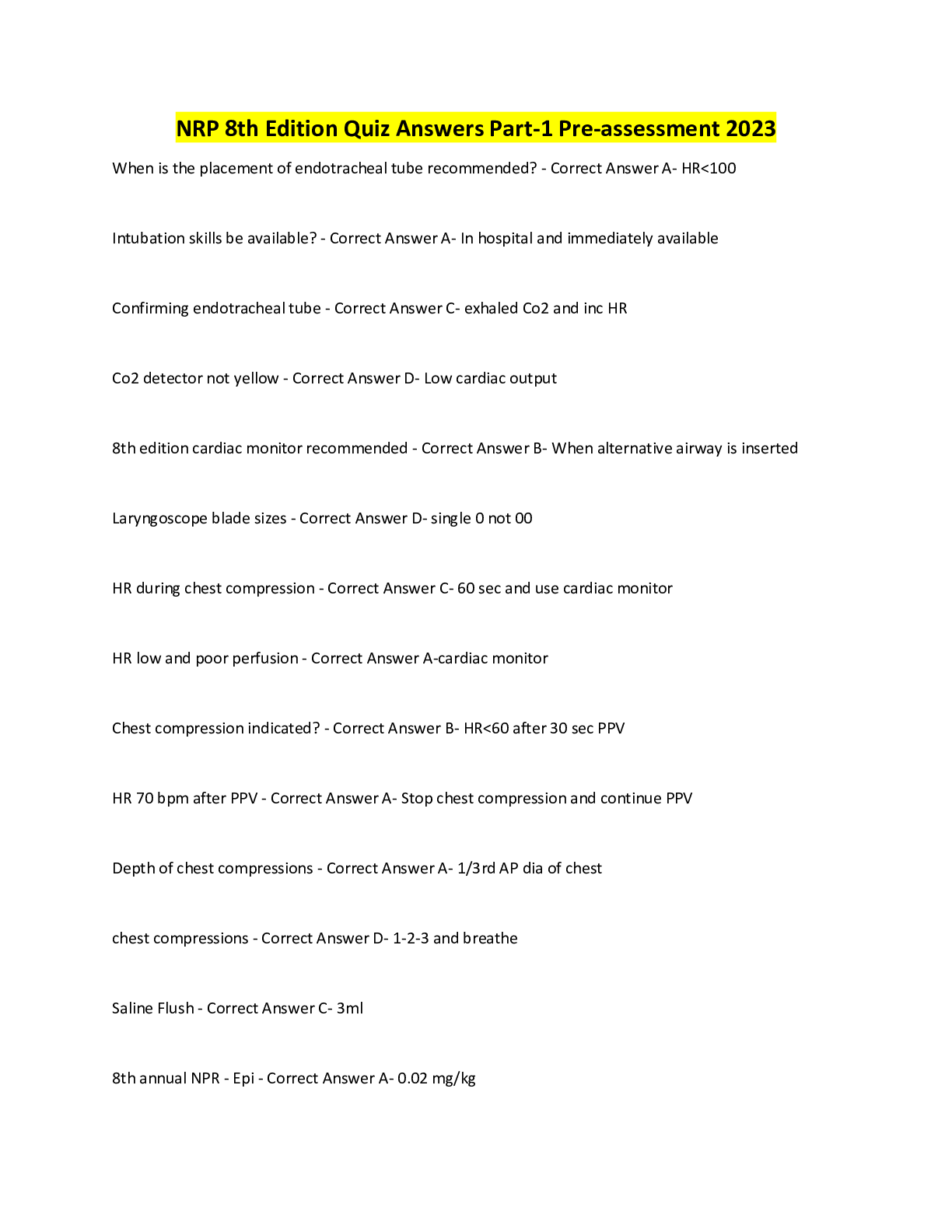

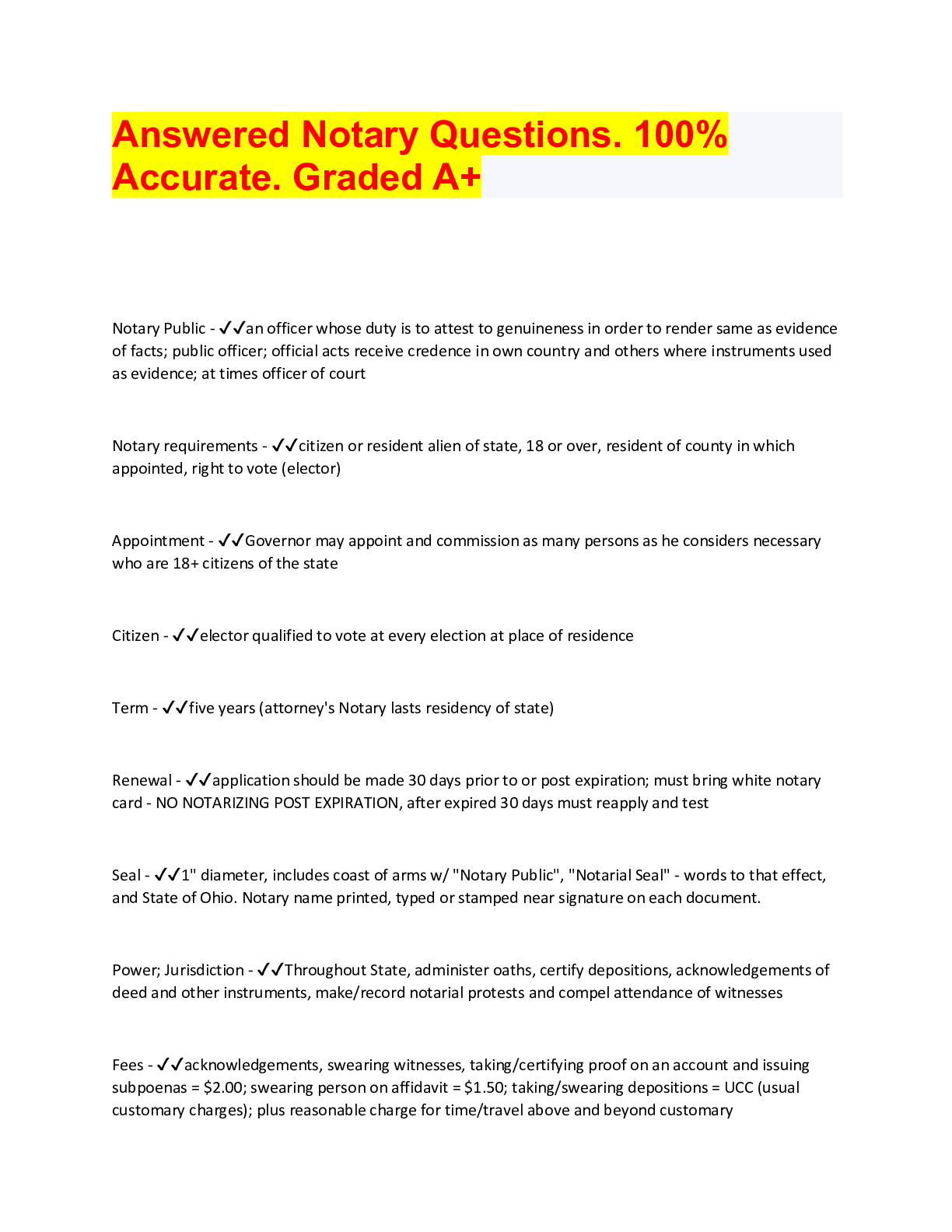

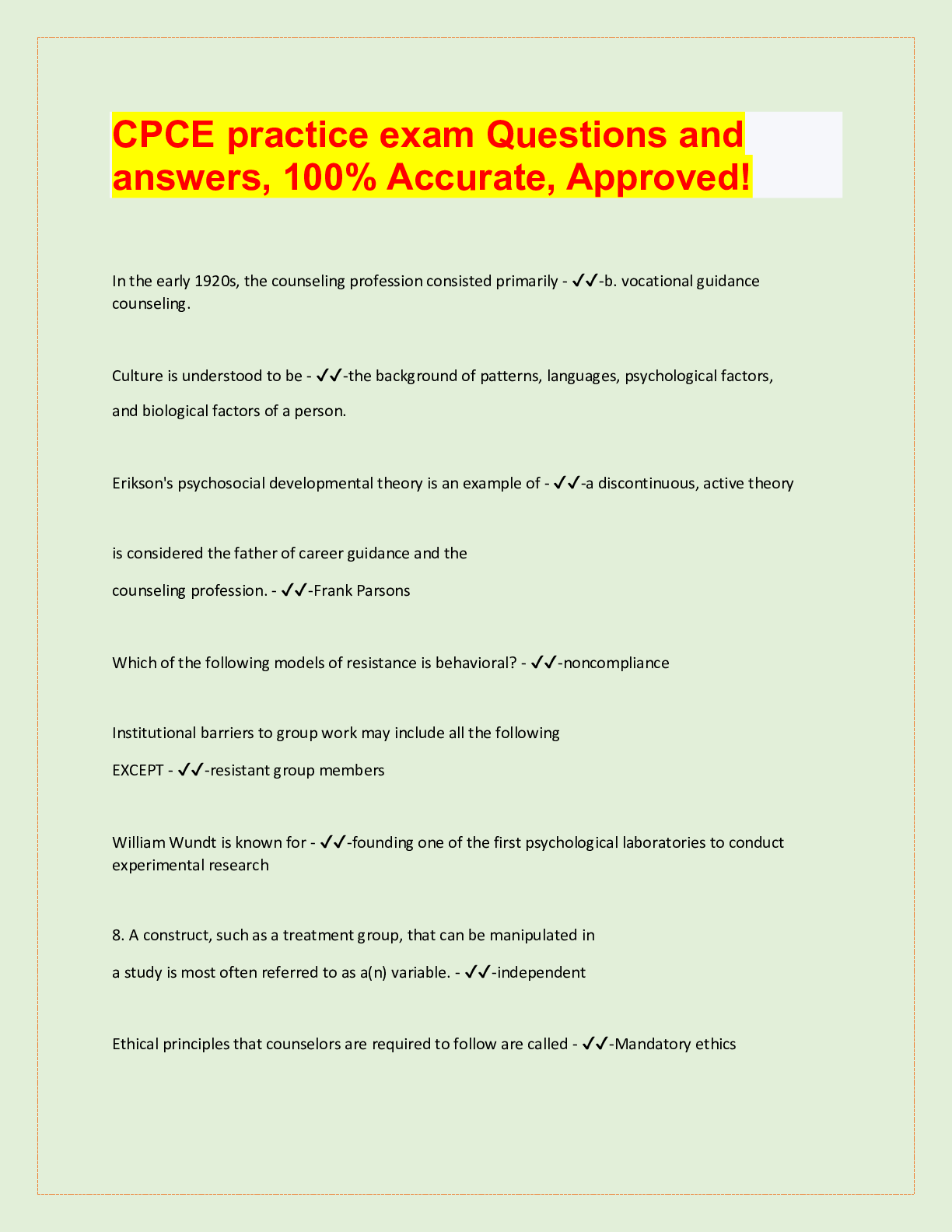
.png)

